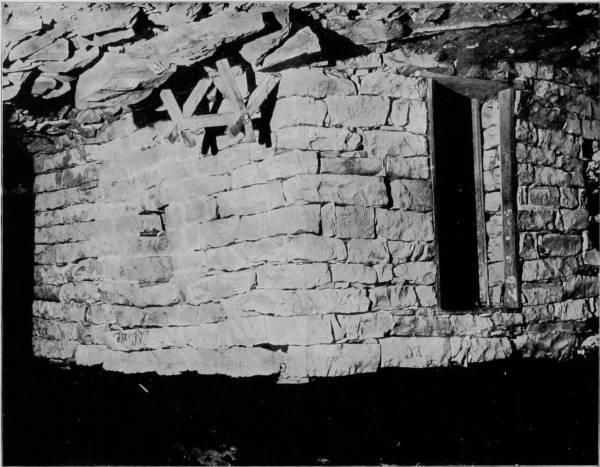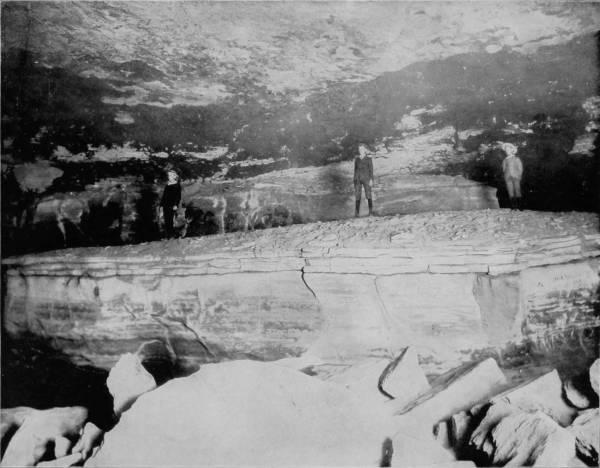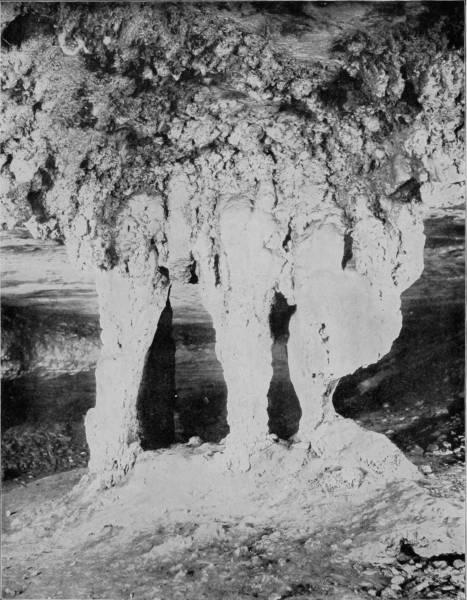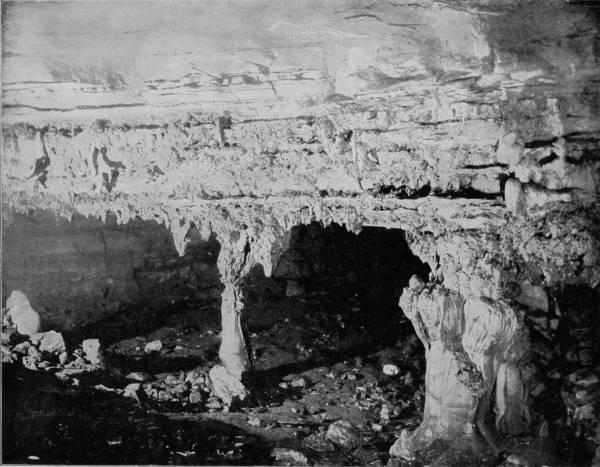Exploring the Variety of Random Documents with Different Content
Having completed our work in New Orleans, and a tour of the Southeast, or at least that portion which is noted for its semi-tropical characteristics and great picturesqueness, we took train on the Louisville and Nashville Railroad for Mammoth Cave, to make an inspection and photographic tour of that world-wonderful natural curiosity. To reach the Cave our route was northeast through Birmingham, Nashville, and thence to Glasgow Junction, at which point connection is made with a little spur of the Louisville and Nashville Road, which runs directly to the Cave, a distance of twelve miles from the Junction. Mammoth Cave is in the eastern part of Edmondson county, Kentucky, eighty-five miles south of Louisville, and its entrance is in a forest ravine nearly two hundred feet above Green River, where the banks are very steep and high. It is said to have been discovered in 1809 by a hunter named Hutchins, while pursuing a wounded bear that had taken refuge in a wide crevice that led directly into a broad chamber of the Cave. The history of this discovery is not sufficiently definite to enable us to know which one of the two points of entrance was thus accidentally found. The present opening used is in the ravine mentioned, but the original mouth is believed to have been the aperture that is nearly a quarter of a mile above, and leads into what is known as Dixon’s Cave, a disconnected branch of Mammoth Cavern.
Luray Caverns are lighted by electricity, so that photographing its many chambers and beautiful stalactitic formations is easily accomplished; but though Mammoth Cave is the largest and best known of the world’s great subterranean recesses, and visited by about 6,000 persons annually, no provision has been made for lighting, beyond the crude method of guides who carry torches and candles. To photograph its dark rivers, avenues, configurations, and strange sculpturings many attempts have been made by the aid of magnesium lights, but without satisfactory results until Mr. Ben. Hains, of New Albany, Indiana, made special and most careful preparations to do the work which had so often failed in the hands
of others. Several weeks were spent in the cave testing the powerful artificial lights which he had provided, and by dint of perseverance he was at last rewarded by the most perfect results. To this enterprising gentleman we are indebted for the use of the photographs from which our reproductions are made.
Mammoth Cave first came into notice and importance about the year 1812, when it was discovered that the cave contained vast beds of niter, sufficient, as was stated at the time, to supply the whole population of the globe with saltpeter. Gratz and Williams were the owners, and established a very large industry in collecting the nitrous earth by means of ox-carts and shipping it to Philadelphia, where it was used in manufacturing the gun-powder that enabled us to triumph over England a second time. The region is essentially cavernous, as Professor Shaler estimates that in this carboniferous limestone district of Kentucky “there are at least 100,000 miles of open caverns,” but very few of the five hundred caves and grottoes of Edmondson county contain nitrous earth. On the other hand, there have been very few evidences of prehistoric occupancy discovered in Mammoth Cave, while in Salt Cave, its neighbor, and almost a rival in size, archæologic remains, such as fire-places, burnt torches, sandals, and moccasin-prints are numerous; and in Short Cave, also near-by, the mummified bodies of several small animals and a few human remains have been found. White Cave is half a mile from the Mammoth Cave entrance, and the two may be connected, though the communication has not been discovered. But there is a decided difference in the formations that characterize the two. White Cave is in some respects similar to Luray Caverns in its exquisitely charming variety of stalactites. In the first chamber, “Little Bat Room,” as it is called, we find many lovely creations and a few objects of great interest to paleontologists. In the second room is a piece of stalactitic drapery, which has been very appropriately called the “Frozen Cascade.” “Humboldt’s Pillar” and “Bishop’s Dome” are other wonderful examples of the effects of slowly percolating water bearing lime in solution. In this same cave, some seventy years ago, were found huge fossil bones, of the megalonyx, or giant
sloth, bear, bison, and stag, and scattered among these animal remains were a few human bones.
But while the adjacent caves each possess an interest peculiar to themselves, Mammoth Cave must continue to remain the most remarkable cavern in our country, not only for its size, but likewise for the marvels which exploration of its labyrinthine avenues has revealed. To Professor H. C. Hovey’s admirable and scientific description of the Cave I acknowledge my indebtedness for a larger part of the information here imparted, from which, also, liberal extracts are made, though without quotation credit.
OLD STONE HOUSE, MAMMOTH CAVE.
The dry atmospheric condition of the galleries of Mammoth Cave led to a belief some forty years ago that a continuous residence within these dark precincts for a definite period would be beneficial to consumptives. The experiment was therefore made by building a number of stone houses or huts at a point about a mile within the cave, in which a colony of invalids took up their abodes and lived in deep seclusion until it was demonstrated by the death of several of the sufferers that they derived no benefit from the surroundings. Relics of two of these stone huts still remain, but they exist now only as curiosities, no one having spent a night in either of them for many years.
The entrance to Mammoth Cave is arched by a rock-span of seventy feet, thence leading by an easy descent down a winding flight of stone steps to a narrow passage through which the air rushes outward with great force in summer and is drawn inward with corresponding violence during the winter, a phenomenon due to the inequality of temperature between the air inside and out of the Cave, for the temperature of the Cave is uniformly 54° Fahrenheit at all times. The atmosphere being thus constantly agitated, is kept constantly pure, for while the lower levels are moist, being no doubt connected with Green River, the upper avenues and galleries are always dry; conditions which were one time thought to be particularly favorable to consumptives, as well as to those suffering from other wasting diseases. The experiment was therefore made, some forty years ago, of building thirteen stone houses at a point one mile within the Cave, in which a number of invalids took up their domicile and lived there in deep seclusion until it was demonstrated that whatever might be the salubrity of the atmosphere, consumptives derived no benefit from it, a number dying in the Cave. Relics of two of these stone huts still remain, but they exist now only as curiosities, no one having spent a night in one of them for many years.
The main cave is from 40 to 300 feet wide and from 35 to 125 feet high, divided into a great number of rooms and winding avenues, the extent of which has not yet been determined, for exploration of the Cave is far from being complete. Some of the best known rooms are, first, the Rotunda, in which are ruins of the old saltpeter works, and where the skeletons of two men were found several years ago. Beyond this is the Star Chamber, where the protrusion of white crystals through a coating of black oxide of manganese creates an optical illusion of great beauty. Another department is called the Chief City, a chamber of nearly two acres space, with a vaulted roof 125 feet high. The floor is bestrewn with rocks, among which have been found charred torches of cone, and a
few other evidences of prehistoric occupancy. There are also shown some mummified bodies, preserved by their inhumation in nitrous earth, utensils, ornaments, braided sandals, and other relics, but all of these were found in Salt and Short Caves, near-by, and removed to Mammoth Cave for exhibition. The main cave ends four miles from the entrance, but is joined to other spacious chambers by winding passages leading to different levels, so that while the cavern area is perhaps less than ten miles, the total length of the avenues is supposed to be 150 miles.
The chief places of interest are found along two main lines of the explored portions, from which side excursions may be made. The “short route” may be covered in about four hours, but it requires nine hours to traverse what is known as the “long route.” Audubon Avenue is the first leadway, interesting for the swarms of bats that hang in huge clusters from the ceiling, but it is not until Gothic Avenue is reached that stalactites and stalagmites are met with. This passage leads into the Chapel, at the end of which is a beautiful double dome and cascade; thence we pass into the Throne-Room, with its royal formations of surprising splendors, which compel visitors to stop, and elicit exclamations of wonder and admiration. The Bridal Altar is almost equally grand, with its frosted pillars of pearl-white, and the convolutions of their magnificent pediments that may be likened to clouds in the sky of cave. Indeed, these vertical shafts or petrified columns are among the most surprising features of cave scenery. They are not confined to the Bridal Altar, however, for they pierce through all levels, from the uppermost galleries to the lowest floors, and even find lodgment in the sinkholes.
A block of stone that is forty feet long by twenty feet wide is called the Giant’s Coffin, and when viewed from a certain angle the resemblance to a funeral casket is so great that even if attention were not called to it, visitors would hardly fail to be a little shocked by the sight. There is a narrow passage-way around the coffin, which followed leads to a large vault called Gorin’s Dome, in which there are six pits varying in depth from 65 to 220 feet; truly, awful
pits to fall into. Notwithstanding the treacherous character of the floor, Gorin’s Dome is one of the finest chambers in the Cave, for it is charmingly festooned and pillared with stalactitic formations. Mammoth Dome, which is at the termination of Sparks Avenue, is probably more interesting, because besides having its walls draped with a marvelous tapestry, the great wonder of the room is immensely increased and beautified by a cataract, which falls from a height of 250 feet and fills the apartment with its musical splashings. The Egyptian Temple, which is a continuation of the Mammoth Dome, contains six massive columns, two of which are quite perfect and eighty feet high by twenty-five feet in diameter. Lucy’s Dome, which is three hundred feet high, is the loftiest of these monster shafts, the equal of which cannot be found in any known cave in the world.
BEAUTIFUL BOW VALLEY.
One of the peculiarly attractive and picturesquely exquisite portions of British America is mountain-begirted Bow Valley, 500 miles east of Vancouver, along the Canadian Pacific Railway line. The region is wondrously diversified and marvelously beautiful, holding within its compass not only a valley of paradisaic charms, but also mountains of startling grandeur, with crystalline lakes reposing on their bosoms, range breaking beyond range, snowy crests gleaming with sunlight splendors, forests tinted with softest hues, streams that murmur and cascades that roar, while the valley is aflame with the richest colorings of daisies, buttercups, bluebells, heather, wild pinks, anemones, and brianthus, a symphony of beauty, a colossal bouquet decorating the marriage-bed of nature.
GIANT’S COFFIN, MAMMOTH CAVE, KENTUCKY.—
This remarkable and weird curiosity is composed of a huge block of stone forty feet long by twenty wide, and when viewed from a certain angle the resemblance to a funeral casket is so great that, even if attention were not called to it, visitors would hardly fail to be a little shocked by the uncanny sight. Standing within its presence it is almost impossible to divest one’s self of the belief that he is gazing upon the last resting-place of some tremendous giant, the guardian genius, perhaps, of this lugubrious subterranean abode; and it is with a sigh of relief that we pass on to more inspiring and splendid scenery.
The Maelstrom, in Croghan’s Hall, is one of the deepest and most awful-appearing pits yet discovered, and until 1859 no one had ever ventured to explore its dark recesses. It is at a remote point in the Cave and seldom visited, because the way is beset with obstacles, while the sight is neither reassuring nor compensating. A son of George D. Prentice, however, braved the dangers of the pit by permitting some of his friends to lower him 190 feet by a rope to the bottom, but his experience was of little value, because he found nothing of interest to reward him for the trouble. Some pretty stalactites are near this pit, and also in Fairy Grotto, but in the deeper recesses there is a remarkable absence of these formations. Indeed, considering the character and extent of Mammoth Cave, its poverty of stalactitic ornamentation is surprising. On the other hand, it contains an unexampled wealth of crystals of endless variety and incomparable beauty. Besides the sparkling vault of the Star Chamber, which is 300 feet long and 80 feet high, there are halls canopied by fleecy clouds, or studded by mimic snow-balls, and others displaying various grotesque resemblances on the walls and ceilings. Cleveland’s Cabinet, and Marion’s Avenue, each a mile long, are adorned by myriads of gypsum rosettes and curiously twisted crystals called “oulopholites.” These cave-flowers are unfolded by pressure, like a sheaf of wheat forced through a tight binding. This charming embellishment of clusters and garlands is frequently seen curling outward, like roses, composing petrified bouquets that cover the snowy arches.
This curious feature is even more marked by the stalactites in Mary’s Vineyard, where they appear in the form of an aggregation of spherical prominences, resembling clusters of grapes. Other chambers are drifted with snowy crystals of sulphate of magnesia, and the ceilings are so thickly covered with their efflorescence that a sharp concussion of the air will cause them to fall like flakes in a snow-storm.
Many small rooms and tortuous paths, where danger lies, are avoided as much as possible; but even on the regular routes through the Cave some disagreeable experiences are inevitable, while about the deep pits peril is always present. The one now known as the Bottomless Pit was for many years a barrier to all further exploration, and until a substantial wooden bridge was built across it. Long before the shaft had been cut as deep as now, the water flowed away by a channel gradually contracting until at a point called The Fat Man’s Misery the walls were only eighteen inches apart. The rocky sides are beautifully marked with waves and ripples, as if running water had been suddenly petrified. This winding-way conducts to River Hall, beyond which lie the crystalline gardens that have been described. It was formerly believed that if this narrow passage were closed, escape would be impossible; but a few years ago a tortuous fissure called the Cork-Screw was discovered, by means of which a good climber ascending a few hundred feet finally lands 1,000 yards from the mouth of the Cave, and cuts off nearly two miles.
The waters, entering through numerous domes and pits, and falling, during the rainy season, in cascades of great volume, are finally collected in River Hall, where they form several extensive lakes, or rivers, whose connection with Green River is known to be in two deep springs appearing under arches on its margin. Whenever there is a freshet in Green River the streams in the cave are joined in a continuous body of water, the rise sometimes being as much as sixty feet above the low-water mark. The subsidence within is less rapid than the rise; and the streams are impassable during a greater part of the year. They are usually navigable from May to October, and furnish exceedingly interesting as well as novel features of cave scenery. The largest body of water is called the Dead Sea, embraced within a basin formed by cliffs sixty feet high, above which a path has been made which leads to a stairway and thence to the River Styx, a body of water that is four hundred feet long and forty feet wide. Lake Lethe is the next water-basin, enclosed by walls ninety feet high, below which is a path that conducts to a pontoon at the
neck of the lake. Thence a beach of the finest yellow sand extends for 500 yards to Echo River, the largest of all, being nearly one mile long, from 20 to 200 feet broad, and varying in depth from 10 to 40 feet. Two or three boats are placed on this Lethean or Stygian stream, in which visitors are taken from one end of the river to the other, and the trip is of such novelty that the remembrance of it is imperishable. To see the boats approaching, in the weird light of flickering torches, is like a vision of a spectral crew, funereal, sepulchral and almost horrific. The arch overhead is symmetrical but irregular in height, and is famous for its musical reverberations—not a distinct echo, for the repetitions are so rapid that they merge and become a prolongation of sound that continues for nearly half a minute. The long vault has a certain key-note of its own, which, when sounded, produces harmonies of almost incredible depth and sweetness.
THE BRIDAL ALTAR, MAMMOTH CAVE.—
The Bridal Altar is one of the most magnificent spectacles of Mammoth Cave, with its frosted pillars of pearlwhite and the convolutions of their magnificent pediments that may be likened to clouds in the sky of the cave. These vertical shafts or petrified columns are among the most surprising and beautiful features of cave scenery, and when brilliantly lighted they present a scene of splendor surpassing the utmost stretch of the imagination. Let us not, therefore, wonder that this is a favorite resort for young married people, who come hither in the rosy blush of their
wedding dawn to plight the faith that makes them one for time and eternity.
In these Plutonian regions of perpetual night, where vegetation is only imaged by petrified efflorescence, many creatures find a congenial abode, and become so accustomed to this dark habitat that they cannot live elsewhere. Of the twenty-eight different species here found, the most remarkable are a blind and wingless grasshopper with extremely long antennae; a blind and colorless cray-fish, and a blind fish which grows to the length of six inches. These fish possess the additional curiosity of being viviparous, or producing their young in a living state, instead of by eggs. Occasionally other fish are caught in the running streams of the Cave which are identical with species common in Green River, thus proving the subterranean connection that exists between that river and the Cave streams.
The strongly marked divergence of these blind creatures from those found on the outside led Agassiz to believe that they were specially created for the limits within which they dwell; but the opinion now generally held is that they are modifications of allied species existing in the sunlight, and that their peculiarities are to be accounted for on the principles of evolution—the process of change being accelerated, or retarded, by their migration from the outer world to a region of silence and perpetual darkness.
Having concluded our examination of Mammoth Cave, we departed by the Louisville and Nashville Railroad for Louisville, at which city train was taken on the St. Louis Air Line for Wyandotte Cave, which was to be our last objective point in completing our extensive photographic tour of America. This very remarkable Cave, though not so generally known as Luray or Mammoth, is about ten miles south of the Louisville and St. Louis Air Line, in Crawford county, Indiana, and is only five miles from the Ohio River. We reached the Cave by way of Milltown, thence to Corydon, and from that point by private conveyance a distance of eleven miles. Entrance to the Cave is by way of a large opening in a hillside, the aperture being about six feet high and twenty feet wide, through
which there is always a strong circulation of air like that noted at the mouth of Mammoth Cave, while the temperature is likewise uniformly 54° Fahrenheit. A short avenue leads into a chamber known as Fanueil Hall, whose dimensions are 200 feet long, 50 feet wide and 25 feet high; thence the route conducts through Twilight Hall into Columbian Arch, which resembles a railroad tunnel, so symmetrical is the excavation. Washington Avenue is next entered, which, followed, brings the visitor to Banditti Hall, where the ceiling rises to an immense height, and the walls are jagged, as is the floor, with protruding rocks, so that this chamber is both forbidding in appearance and difficult to traverse. At this point the main gallery branches, one avenue leading to what is known as the Old Cave, and the other conducting by a longer route to more interesting apartments than those before passed. Through a narrow crevice the visitor gains a room called the Bats’ Lodge, and beyond this is Rugged Mountain, which is in the center of a circular room, where Epsom salts of sparkling purity and vast quantities of gypsum in efflorescent beauty cover the arched vault. Seen under torch-light the effect is indescribably magnificent, and is the first striking intimation which the visitor receives of the extraordinary grandeur to which he will be presently introduced. Following the long route we cross a lovely sand-deposit known as the Plain, but find an abrupt termination of this level walk and are compelled to climb the rockbestrewn Hill of Difficulty, then squeeze through a small passageway from which we find present relief by emerging into Wallace’s Grand Dome, one of the most magnificent chambers, as well as the largest, in the Cave, being 245 feet high and 300 feet in diameter. In the center is Monument Mountain, a tremendous stalagmite formation above which is an immense dome beflowered with curling leaves of gypsum that bear a wondrous likeness to the foliage of the acanthus. At the apex of the mountain is a stalagmite one hundred and twenty feet in circumference, which has been broken by some force into three columns, which, viewed from the base, admirably counterfeit three monuments, or ghosts clad in robes of gleaming whiteness, from which fact the chamber takes its name. Visitors are usually treated to a superbly grand sight while examining the
splendors of this hall, for the guide disposes his company about the base of the mountain, and ascending to the summit he extinguishes his torch in order to bring the visitors under the influence of dense darkness for a few moments. Suddenly the peak is lighted up with a dazzling splendor, as the guide touches off green, blue, red and orange lights, bathing the chamber in a sea of flaming beauty and bejewelling its lofty arch until Aladdin’s Cave of our imagination is reproduced.
THE RIVER STYX, MAMMOTH CAVE, KENTUCKY.
Some idea of the grandeur of the waterways of Mammoth Cave will be obtained from the following description: The largest body of water is called the Dead Sea, embraced within a basin formed by cliffs sixty feet high, above which a path has been made leading to a stairway and thence to the River Styx, which is forty feet wide and four hundred long. Lake Lethe is the next water-basin, enclosed by walls ninety feet high, below which is a path that conducts to a pontoon at the neck of the lake. Thence a beach of the finest yellow sand extends for five hundred yards to Echo River, the largest of all, being nearly one mile long, from twenty to two hundred feet broad, and varying in depth from ten to forty feet. Two or three boats ply this Stygian stream, in which visitors are taken from one end to the other, and the trip is of such novelty that the remembrance of it is imperishable.
ENTRANCE TO PILLARED PALACE, WYANDOTTE CAVE.—
There are many grand and splendid halls in Wyandotte Cave, of which the most attractive is Pillared Palace, in which gypsum and stalactites occur in the most charming and imposing forms. This hall is particularly entrancing in its sumptuous and architecturally beautiful decorations. It is from five to six feet high, forty or fifty wide and several hundred long. The ceiling is a complete fringework of stalactites, while the floor is as thickly set with stalagmites, many of which uniting with the former produce pillars of the grandest proportions, beautiful beyond the power of imagination to describe. Drapery of every conceivable style is seen in the utmost profusion, some of it transparent as crystal and resonant as a silver bell when struck with a metal substance.
THE THRONE, WYANDOTTE CAVE.—
Although less celebrated than Mammoth or Luray Caves, Wyandotte fully equals them in many of its wondrous and beautiful formations. The Throne and the hall in which it is located are truly marvels of Nature’s handiwork. Imagine great bunches of white, delicate, branching coral, twisting, curling and interlacing itself, serpent-like, into every conceivable fantastic shape, and you have only a faint idea of the truly extraordinary scenery of this glorious temple erected by Nature. In all directions are to be seen fantastic examples of stalactite formations, and marvelous decorations of whitest gypsum. Huge rocks, overhung by galleries of creamy stalactites, with vermicular tubes intertwined, while frozen cataracts and vine-like pendent forms cluster along the walls in a profusion almost incredible.
Beyond Wallace’s Dome there are a hundred halls of great magnificence, in nearly all of which are seen fantastic examples of stalactite formations, and marvelous decorations of whitest gypsum, Milroy’s Temple being a very exhibition-room of these exquisite curiosities: huge rocks, overhung by galleries of creamy stalactites, vermicular tubes intertwined, frozen cataracts and vine-like pendant forms of stalactites, cluster along the walls in a profusion almost incredible. Imagine great masses of white delicate branching coral, twisting, curling and interlacing itself, serpent-like, into every conceivable fantastic shape, and you have only a faint idea of the truly extraordinary scenery of this glorious temple erected by nature. Other halls of almost rival splendor are known as Snowy Cliffs, Frosted Rocks, Fairy Palace, Beauty’s Bower, The Throne, and Pillared Palace, in all of which gypsum and stalactites occur in the most charming and imposing forms. Pillared Palace is particularly entrancing in its sumptuous and architecturally beautiful decorations. It is from five to six feet high, forty or fifty feet wide and several hundred feet long. Its ceiling is a complete fringe-work of stalactites, while its floor is as thickly set with stalagmites, many of which latter unite with the former, making the grandest pillars. Drapery of every conceivable style may be seen, some of which is as transparent as crystal and rings like a silver bell when exposed to a light blow. After Pillared Palace comes the Palace of the Genii, which for delicate formations even excels the former. Here are found stalactites of every conceivable form, many of them as white as if they were made of sugar or whitest marble.
Passing through Fairy Grotto, Neptune’s Retreat, and Hermit’s Cell, the visitor enters a larger chamber invested with the same charming ornamentation, and in the center is a rich canopy of stalactite overhanging a stalagmite which has been likened by some imaginative person to a chair richly upholstered. This is called the Throne, a designation appropriate enough, for it is one of the most royally beautiful curiosities in the Cave, as the illustration will show.
That portion known as the Old Cave, while scarcely so interesting as the galleries and vaults of the long route, contains several halls of much interest and one, called the Senate Chamber, which rivals Wallace’s Dome. In the center of this room stands a mountain whose top is covered many feet deep with stalactite formations, upon which stands the Pillar of the Constitution. This is an immense stalagmite measuring seventy-five feet in circumference and thirty feet high, reaching from the top of the mountain to the ceiling above, fluted and carved after a manner that would have put to shame the most extravagant architecture of Rome’s most halcyon days. The world has not yet produced, so far as civilized man knows, anything of the kind to equal it. A writer says of it:
“Before us arose a considerable hill, upon the top of which stood, like a column supporting the ceiling, a vast stalagmite like an immense spectral-looking iceberg looming up before us, appearing as though it had just arisen from the foaming waves of the ocean, on a dark and foggy night. In the uncertain light of our lamps it presented an appearance grand, if not appalling; but when the Drummond light had been set off, all this changed to the most unearthly beauty. The ceiling above, with its long fringes of stalactites, came out to view, and the great pillar could be seen in all its grandeur and beauty.”
Beyond this is Pluto’s Ravine, where stands Stallasso’s Monument, a large white stalagmite, marked all over with pencil inscriptions, some of them sixty years old, composing an autograph album of wonderful curiosity, containing hundreds of names which to fame are otherwise unknown, and effusions of doggerel poets whose reputations, alas, will no doubt be forever restricted to the limits of this cave chamber. A short distance beyond Pluto’s Ravine is the termination of this section of the Cave, and from this point return is made to the open air. A ramble among the subterranean glories and petrified splendors of Wyandotte Cave was a fitting conclusion to one of the most interesting tours that was ever taken through the picturesque regions of our country; a tour affording so much information, pleasure, adventure, and profit, that the remembrance
must forever remain a source of intense satisfaction and delight. It was with feelings of deep regret that we separated after the completion of our work, and each returned to his respective home, to take up anew the old labor which we had laid down when the start was made upon our long journey. During the trip our photographers took five thousand pictures; many of these were taken under unfavorable conditions, and upon development were found unworthy of reproduction. Many others were excellent and well deserving to rank with those which we have here used, but there is a limit to all things, and ours does not exceed the space occupied by the 520 odd views which we have presented; these, however, are fairly representative of the incomparable scenery that charmingly diversifies our native land, a land kissed by the lips of liberty, bounty, and beauty, and blessed with an amplitude of powers, under the exercise of which the largest freedom, benefits and sovereign rights are obtained for the whole people.
[THE END.]
*** END OF
THE PROJECT GUTENBERG EBOOK GLIMPSES OF AMERICA
***
Updated editions will replace the previous one—the old editions will be renamed.
Creating the works from print editions not protected by U.S. copyright law means that no one owns a United States copyright in these works, so the Foundation (and you!) can copy and distribute it in the United States without permission and without paying copyright royalties. Special rules, set forth in the General Terms of Use part of this license, apply to copying and distributing Project Gutenberg™ electronic works to protect the PROJECT GUTENBERG™ concept and trademark. Project Gutenberg is a registered trademark, and may not be used if you charge for an eBook, except by following the terms of the trademark license, including paying royalties for use of the Project Gutenberg trademark. If you do not charge anything for copies of this eBook, complying with the trademark license is very easy. You may use this eBook for nearly any purpose such as creation of derivative works, reports, performances and research. Project Gutenberg eBooks may be modified and printed and given away you may do practically ANYTHING in the United States with eBooks not protected by U.S. copyright law. Redistribution is subject to the trademark license, especially commercial redistribution.
START: FULL LICENSE
THE FULL PROJECT GUTENBERG LICENSE
PLEASE READ THIS BEFORE YOU DISTRIBUTE OR USE THIS WORK
To protect the Project Gutenberg™ mission of promoting the free distribution of electronic works, by using or distributing this work (or any other work associated in any way with the phrase “Project Gutenberg”), you agree to comply with all the terms of the Full Project Gutenberg™ License available with this file or online at www.gutenberg.org/license.
Section 1. General Terms of Use and Redistributing Project Gutenberg™ electronic works
1.A. By reading or using any part of this Project Gutenberg™ electronic work, you indicate that you have read, understand, agree to and accept all the terms of this license and intellectual property (trademark/copyright) agreement. If you do not agree to abide by all the terms of this agreement, you must cease using and return or destroy all copies of Project Gutenberg™ electronic works in your possession. If you paid a fee for obtaining a copy of or access to a Project Gutenberg™ electronic work and you do not agree to be bound by the terms of this agreement, you may obtain a refund from the person or entity to whom you paid the fee as set forth in paragraph 1.E.8.
1.B. “Project Gutenberg” is a registered trademark. It may only be used on or associated in any way with an electronic work by people who agree to be bound by the terms of this agreement. There are a few things that you can do with most Project Gutenberg™ electronic works even without complying with the full terms of this agreement. See paragraph 1.C below. There are a lot of things you can do with Project Gutenberg™ electronic works if you follow the terms of this agreement and help preserve free future access to Project Gutenberg™ electronic works. See paragraph 1.E below.
1.C. The Project Gutenberg Literary Archive Foundation (“the Foundation” or PGLAF), owns a compilation copyright in the collection of Project Gutenberg™ electronic works. Nearly all the individual works in the collection are in the public domain in the United States. If an individual work is unprotected by copyright law in the United States and you are located in the United States, we do not claim a right to prevent you from copying, distributing, performing, displaying or creating derivative works based on the work as long as all references to Project Gutenberg are removed. Of course, we hope that you will support the Project Gutenberg™ mission of promoting free access to electronic works by freely sharing Project Gutenberg™ works in compliance with the terms of this agreement for keeping the Project Gutenberg™ name associated with the work. You can easily comply with the terms of this agreement by keeping this work in the same format with its attached full Project Gutenberg™ License when you share it without charge with others.
1.D. The copyright laws of the place where you are located also govern what you can do with this work. Copyright laws in most countries are in a constant state of change. If you are outside the United States, check the laws of your country in addition to the terms of this agreement before downloading, copying, displaying, performing, distributing or creating derivative works based on this work or any other Project Gutenberg™ work. The Foundation makes no representations concerning the copyright status of any work in any country other than the United States.
1.E. Unless you have removed all references to Project Gutenberg:
1.E.1. The following sentence, with active links to, or other immediate access to, the full Project Gutenberg™ License must appear prominently whenever any copy of a Project Gutenberg™ work (any work on which the phrase “Project
Gutenberg” appears, or with which the phrase “Project Gutenberg” is associated) is accessed, displayed, performed, viewed, copied or distributed:
This eBook is for the use of anyone anywhere in the United States and most other parts of the world at no cost and with almost no restrictions whatsoever. You may copy it, give it away or re-use it under the terms of the Project Gutenberg License included with this eBook or online at www.gutenberg.org. If you are not located in the United States, you will have to check the laws of the country where you are located before using this eBook.
1.E.2. If an individual Project Gutenberg™ electronic work is derived from texts not protected by U.S. copyright law (does not contain a notice indicating that it is posted with permission of the copyright holder), the work can be copied and distributed to anyone in the United States without paying any fees or charges. If you are redistributing or providing access to a work with the phrase “Project Gutenberg” associated with or appearing on the work, you must comply either with the requirements of paragraphs 1.E.1 through 1.E.7 or obtain permission for the use of the work and the Project Gutenberg™ trademark as set forth in paragraphs 1.E.8 or 1.E.9.
1.E.3. If an individual Project Gutenberg™ electronic work is posted with the permission of the copyright holder, your use and distribution must comply with both paragraphs 1.E.1 through 1.E.7 and any additional terms imposed by the copyright holder. Additional terms will be linked to the Project Gutenberg™ License for all works posted with the permission of the copyright holder found at the beginning of this work.
1.E.4. Do not unlink or detach or remove the full Project Gutenberg™ License terms from this work, or any files
containing a part of this work or any other work associated with Project Gutenberg™.
1.E.5. Do not copy, display, perform, distribute or redistribute this electronic work, or any part of this electronic work, without prominently displaying the sentence set forth in paragraph 1.E.1 with active links or immediate access to the full terms of the Project Gutenberg™ License.
1.E.6. You may convert to and distribute this work in any binary, compressed, marked up, nonproprietary or proprietary form, including any word processing or hypertext form. However, if you provide access to or distribute copies of a Project Gutenberg™ work in a format other than “Plain Vanilla ASCII” or other format used in the official version posted on the official Project Gutenberg™ website (www.gutenberg.org), you must, at no additional cost, fee or expense to the user, provide a copy, a means of exporting a copy, or a means of obtaining a copy upon request, of the work in its original “Plain Vanilla ASCII” or other form. Any alternate format must include the full Project Gutenberg™ License as specified in paragraph 1.E.1.
1.E.7. Do not charge a fee for access to, viewing, displaying, performing, copying or distributing any Project Gutenberg™ works unless you comply with paragraph 1.E.8 or 1.E.9.
1.E.8. You may charge a reasonable fee for copies of or providing access to or distributing Project Gutenberg™ electronic works provided that:
• You pay a royalty fee of 20% of the gross profits you derive from the use of Project Gutenberg™ works calculated using the method you already use to calculate your applicable taxes. The fee is owed to the owner of the Project Gutenberg™ trademark, but he has agreed to donate royalties under this paragraph to the Project Gutenberg Literary Archive Foundation. Royalty
payments must be paid within 60 days following each date on which you prepare (or are legally required to prepare) your periodic tax returns. Royalty payments should be clearly marked as such and sent to the Project Gutenberg Literary Archive Foundation at the address specified in Section 4, “Information about donations to the Project Gutenberg Literary Archive Foundation.”
• You provide a full refund of any money paid by a user who notifies you in writing (or by e-mail) within 30 days of receipt that s/he does not agree to the terms of the full Project Gutenberg™ License. You must require such a user to return or destroy all copies of the works possessed in a physical medium and discontinue all use of and all access to other copies of Project Gutenberg™ works.
• You provide, in accordance with paragraph 1.F.3, a full refund of any money paid for a work or a replacement copy, if a defect in the electronic work is discovered and reported to you within 90 days of receipt of the work.
• You comply with all other terms of this agreement for free distribution of Project Gutenberg™ works.
1.E.9. If you wish to charge a fee or distribute a Project Gutenberg™ electronic work or group of works on different terms than are set forth in this agreement, you must obtain permission in writing from the Project Gutenberg Literary Archive Foundation, the manager of the Project Gutenberg™ trademark. Contact the Foundation as set forth in Section 3 below.
1.F.
1.F.1. Project Gutenberg volunteers and employees expend considerable effort to identify, do copyright research on, transcribe and proofread works not protected by U.S. copyright
law in creating the Project Gutenberg™ collection. Despite these efforts, Project Gutenberg™ electronic works, and the medium on which they may be stored, may contain “Defects,” such as, but not limited to, incomplete, inaccurate or corrupt data, transcription errors, a copyright or other intellectual property infringement, a defective or damaged disk or other medium, a computer virus, or computer codes that damage or cannot be read by your equipment.
1.F.2. LIMITED WARRANTY, DISCLAIMER OF DAMAGES - Except for the “Right of Replacement or Refund” described in paragraph 1.F.3, the Project Gutenberg Literary Archive Foundation, the owner of the Project Gutenberg™ trademark, and any other party distributing a Project Gutenberg™ electronic work under this agreement, disclaim all liability to you for damages, costs and expenses, including legal fees. YOU AGREE THAT YOU HAVE NO REMEDIES FOR NEGLIGENCE, STRICT LIABILITY, BREACH OF WARRANTY OR BREACH OF CONTRACT EXCEPT THOSE PROVIDED IN PARAGRAPH 1.F.3. YOU AGREE THAT THE FOUNDATION, THE TRADEMARK OWNER, AND ANY DISTRIBUTOR UNDER THIS AGREEMENT WILL NOT BE LIABLE TO YOU FOR ACTUAL, DIRECT, INDIRECT, CONSEQUENTIAL, PUNITIVE OR INCIDENTAL DAMAGES EVEN IF YOU GIVE NOTICE OF THE POSSIBILITY OF SUCH DAMAGE.
1.F.3. LIMITED RIGHT OF REPLACEMENT OR REFUND - If you discover a defect in this electronic work within 90 days of receiving it, you can receive a refund of the money (if any) you paid for it by sending a written explanation to the person you received the work from. If you received the work on a physical medium, you must return the medium with your written explanation. The person or entity that provided you with the defective work may elect to provide a replacement copy in lieu of a refund. If you received the work electronically, the person or entity providing it to you may choose to give you a second opportunity to receive the work electronically in lieu of a refund.
















